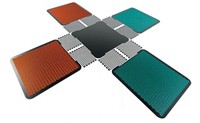Advertisement
Grab your lab coat. Let's get started
Welcome!
Welcome!
Create an account below to get 6 C&EN articles per month, receive newsletters and more - all free.
It seems this is your first time logging in online. Please enter the following information to continue.
As an ACS member you automatically get access to this site. All we need is few more details to create your reading experience.
Not you? Sign in with a different account.
Not you? Sign in with a different account.
ERROR 1
ERROR 1
ERROR 2
ERROR 2
ERROR 2
ERROR 2
ERROR 2
Password and Confirm password must match.
If you have an ACS member number, please enter it here so we can link this account to your membership. (optional)
ERROR 2
ACS values your privacy. By submitting your information, you are gaining access to C&EN and subscribing to our weekly newsletter. We use the information you provide to make your reading experience better, and we will never sell your data to third party members.
Coatings
Using magnetic cubes as microbots
Tiny structures can self-assemble and manipulate individual cells
by Neil Savage, special to C&EN
January 2, 2022
| A version of this story appeared in
Volume 100, Issue 1

Janus cubes—polymer microparticles coated with metal on one side—self-assemble into various structures under the influence of a magnetic field, and manipulating the magnetic field turns the structures into microbots for use in drug delivery, in cell measurement, or as miniature actuators. At a virtual session at the 2021 International Chemical Congress of Pacific Basin Societies, Orlin Velev, a chemical engineer at North Carolina State University, outlined his group’s work. The researchers use photolithography to create polymer cubes about 10 µm across, then coat one side with a 10-nm layer of chromium topped by a 100-nm layer of cobalt. Placing the cubes between two electromagnets causes them to align and form a chain that stays connected after the field is turned off. Oriented one way (trans), the north-south poles of adjoining magnets align into a stiff connection. In the other orientation (cis), they can flip back and forth, so the chains fold and unfold when a magnetic field is applied. The group has made the chain fold around a cell and applied a magnetic gradient to move the captured cell. Another group at Swiss Federal Institute of Technology (ETH), Zurich, has shown it can control the microbots inside a rabbit eye as a possible microsurgical tool. Velev is studying if by squeezing a cell to measure its stiffness, he can determine whether it is healthy or infected with a virus. A related application involves contracting and expanding the chains to act as microactuators and tiny muscles.




Join the conversation
Contact the reporter
Submit a Letter to the Editor for publication
Engage with us on Twitter